Super Mario Galaxy
Genre: 3D Platformer
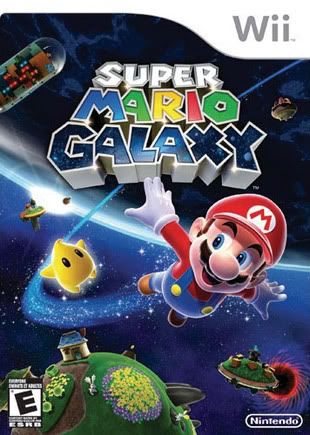
Review by: Average_Joe
Good:
-The level design is superb and the new gameplay mechanics reinvigorate the Mario franchise.
-Wonderful visual style really takes full advantage of the Wii's capabilities.
-Definitely lives up to the high standard of previous Mario games. Best title in the franchise since Mario 64.
Bad:
-It may take some players a while to adjust to the game's unique gameplay.
-The camera moves in strange ways during the space levels.
-The multiplayer mode is weak and feels tacked on.
The plump mascot of Nintendo has been around for what most would label forever. It's a true difficulty to think about video games and not recall pictures, memories and so on of this cheery plumber. He is responsible for an entire generation of gamers with his numerous adventures and antics. Nintendo truly deserves credit for this: they've managed to keep Mario--lets not forget their other main franchises like Zelda and Metroid--relevant across several different platforms and titles, helping to shape the entire industry as a whole along the way.
The Mario series has definitely proven influential: the first Super Mario Bros. game has acquired mainstream status amongst gamers and non-gamers, and deservedly so. Super Mario Bros. 3 was, at the time, a revolutionary title that gave the NES a huge boost late in its life cycle, while Super Mario World helped usher in the 16-bit era and gave the Super Nintendo system a strong push.
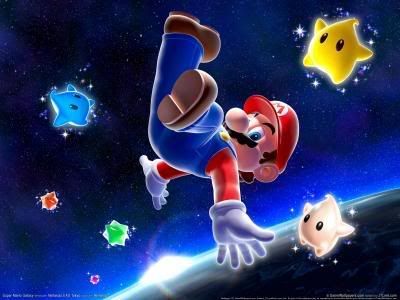
Then came Mario 64, which greatly assisted in opening our eyes to the possibilities of a 3-D world. And we haven't even touched upon related franchises like Mario Kart, Super Smash Bros. and Mario's foray into the RPG realm.
Now onto Galaxy: Super Mario Galaxy starts off with our hero Mario receiving a letter from Princess Peach inviting him to the castle for the Star Festival. When Mario arrives, Peach, The Toads, and everyone else in the Mushroom Kingdom are celebrating something that occurs once every 100 years: the arrival of a giant comet that flies over the Kingdom. Pieces of this comet will break loose and turn into multicolored shooting stars called Star Bits which light the night the sky and crash into the ground.
The festival is running smoothly and everyone is enjoying themselves until Mario's arch enemy intrudes. Bowser and his sinister-looking fleet of airships block out the view of the sky and begin a full scale attack on the kingdom. But this time around, Bowser does more then just snatch the princess, he takes the entire castle using a UFO. No, you read that right: Bowser has a UFO, which means Mario must travel to different galaxies in order to save the princess.
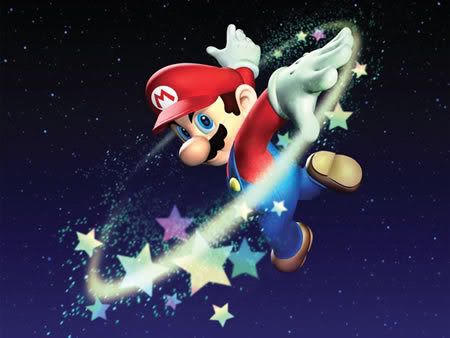
Galaxy's gameplay is split into two main level types: there are levels where Mario is actually in space, jumping from planet to planet and then there are more common platformer levels similar to Mario 64. But in both level types, the player finds good use of the analog stick on the Nunchuk to move around and the Wii Remote to execute Mario's Crash Bandicoot-esque spin attack. The Wii Remote is also capable of collecting Star Bits spread throughout levels which can be fired at enemies and objects on command, which is a key aspect of the game.
The levels where Mario is actually in space definitely provide some of the more interesting moments in the game and offer up a number of new experiences unlike anything we've experienced before in a Mario title. There are a number of miniature planets, each having its own gravitational pull, allowing Mario to run all the way around them literally in simply seconds without floating off into space. The gravity varies depending on what planet Mario is on which may or may not effect the gameplay. The only problem with this new feature is that it can take a few seconds for the camera to adjust.
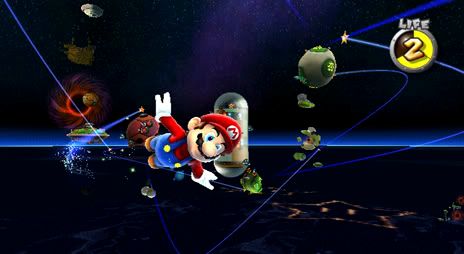
Another great feature for this game is the various power-ups throughout the levels. Each will assist in progressing through the game in some way along with providing a change of appearance. Most of these power-ups are new and fresh but there are also some that are classic to the series such as Fire Mario. Other forms include Bee Mario, allowing Mario to fly for periods of time, Boo Mario which can go through solid objects and Ice Mario which allows the player to walk on water and skate. However there are many other forms. It's quite obvious that the game-developers put a large amount of thought and effort into their design due to how well the power-up are implemented into game-play.
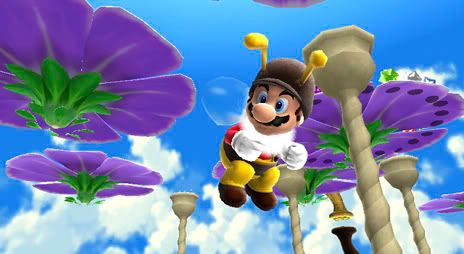
One thing I noticed in the game which I was not too fond of is the so-called two-player mode which seemed gimmicky and tacked on. The only thing the second player is capable of is the ability to collect Star Bits with their Wii Remote, which is pretty much useless. Although the Mario franchise never had a strong, true multiplayer component, so this isn't a huge concern but it is a little perplexing that they'd even bother to have it in the first place.
But this small minor issue aside, it's quite obvious that Super Mario Galaxy raises the bar in terms of what can be achieved on the Wii. There is always so much going on around you as you play through this game, making players want to go back and play again.
Sum Up:
It's everything you loved about Mario 64 and nothing you hated about Super Mario Sunshine
--------------------------------------------------------------
Graphics: 9.5
Sound: 8.5
Gameplay: 9.0
Controls: 9.5
Replay Value: 10
Overall: 9.3
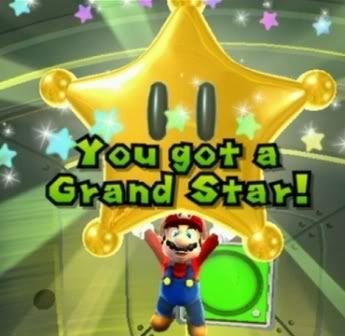

By Average_Joe
Genre: 3D Platformer

Review by: Average_Joe
Good:
-The level design is superb and the new gameplay mechanics reinvigorate the Mario franchise.
-Wonderful visual style really takes full advantage of the Wii's capabilities.
-Definitely lives up to the high standard of previous Mario games. Best title in the franchise since Mario 64.
Bad:
-It may take some players a while to adjust to the game's unique gameplay.
-The camera moves in strange ways during the space levels.
-The multiplayer mode is weak and feels tacked on.
The plump mascot of Nintendo has been around for what most would label forever. It's a true difficulty to think about video games and not recall pictures, memories and so on of this cheery plumber. He is responsible for an entire generation of gamers with his numerous adventures and antics. Nintendo truly deserves credit for this: they've managed to keep Mario--lets not forget their other main franchises like Zelda and Metroid--relevant across several different platforms and titles, helping to shape the entire industry as a whole along the way.
The Mario series has definitely proven influential: the first Super Mario Bros. game has acquired mainstream status amongst gamers and non-gamers, and deservedly so. Super Mario Bros. 3 was, at the time, a revolutionary title that gave the NES a huge boost late in its life cycle, while Super Mario World helped usher in the 16-bit era and gave the Super Nintendo system a strong push.

Then came Mario 64, which greatly assisted in opening our eyes to the possibilities of a 3-D world. And we haven't even touched upon related franchises like Mario Kart, Super Smash Bros. and Mario's foray into the RPG realm.
Now onto Galaxy: Super Mario Galaxy starts off with our hero Mario receiving a letter from Princess Peach inviting him to the castle for the Star Festival. When Mario arrives, Peach, The Toads, and everyone else in the Mushroom Kingdom are celebrating something that occurs once every 100 years: the arrival of a giant comet that flies over the Kingdom. Pieces of this comet will break loose and turn into multicolored shooting stars called Star Bits which light the night the sky and crash into the ground.
The festival is running smoothly and everyone is enjoying themselves until Mario's arch enemy intrudes. Bowser and his sinister-looking fleet of airships block out the view of the sky and begin a full scale attack on the kingdom. But this time around, Bowser does more then just snatch the princess, he takes the entire castle using a UFO. No, you read that right: Bowser has a UFO, which means Mario must travel to different galaxies in order to save the princess.

Galaxy's gameplay is split into two main level types: there are levels where Mario is actually in space, jumping from planet to planet and then there are more common platformer levels similar to Mario 64. But in both level types, the player finds good use of the analog stick on the Nunchuk to move around and the Wii Remote to execute Mario's Crash Bandicoot-esque spin attack. The Wii Remote is also capable of collecting Star Bits spread throughout levels which can be fired at enemies and objects on command, which is a key aspect of the game.
The levels where Mario is actually in space definitely provide some of the more interesting moments in the game and offer up a number of new experiences unlike anything we've experienced before in a Mario title. There are a number of miniature planets, each having its own gravitational pull, allowing Mario to run all the way around them literally in simply seconds without floating off into space. The gravity varies depending on what planet Mario is on which may or may not effect the gameplay. The only problem with this new feature is that it can take a few seconds for the camera to adjust.

Another great feature for this game is the various power-ups throughout the levels. Each will assist in progressing through the game in some way along with providing a change of appearance. Most of these power-ups are new and fresh but there are also some that are classic to the series such as Fire Mario. Other forms include Bee Mario, allowing Mario to fly for periods of time, Boo Mario which can go through solid objects and Ice Mario which allows the player to walk on water and skate. However there are many other forms. It's quite obvious that the game-developers put a large amount of thought and effort into their design due to how well the power-up are implemented into game-play.

One thing I noticed in the game which I was not too fond of is the so-called two-player mode which seemed gimmicky and tacked on. The only thing the second player is capable of is the ability to collect Star Bits with their Wii Remote, which is pretty much useless. Although the Mario franchise never had a strong, true multiplayer component, so this isn't a huge concern but it is a little perplexing that they'd even bother to have it in the first place.
But this small minor issue aside, it's quite obvious that Super Mario Galaxy raises the bar in terms of what can be achieved on the Wii. There is always so much going on around you as you play through this game, making players want to go back and play again.
Sum Up:
It's everything you loved about Mario 64 and nothing you hated about Super Mario Sunshine
--------------------------------------------------------------
Graphics: 9.5
Sound: 8.5
Gameplay: 9.0
Controls: 9.5
Replay Value: 10
Overall: 9.3


By Average_Joe



0 comments:
Post a Comment